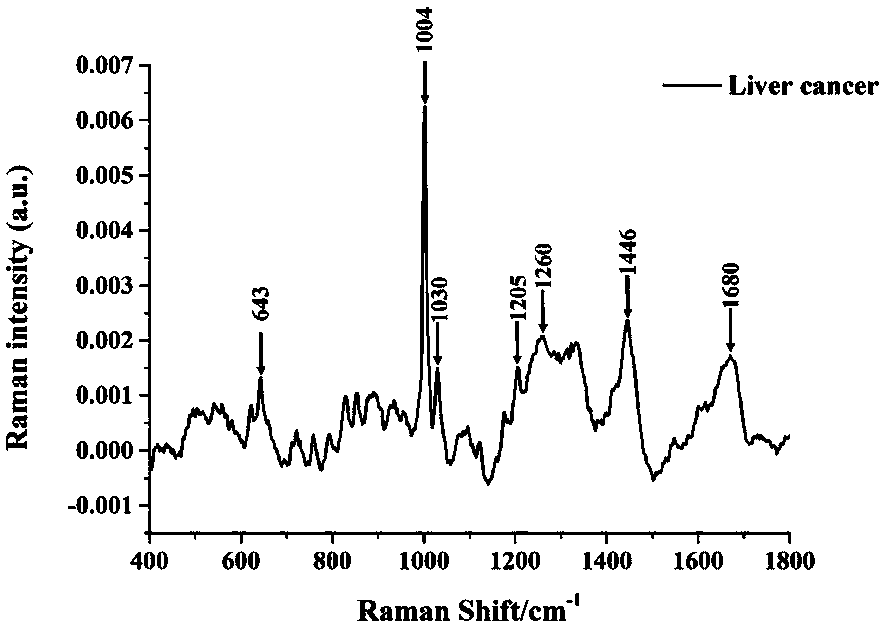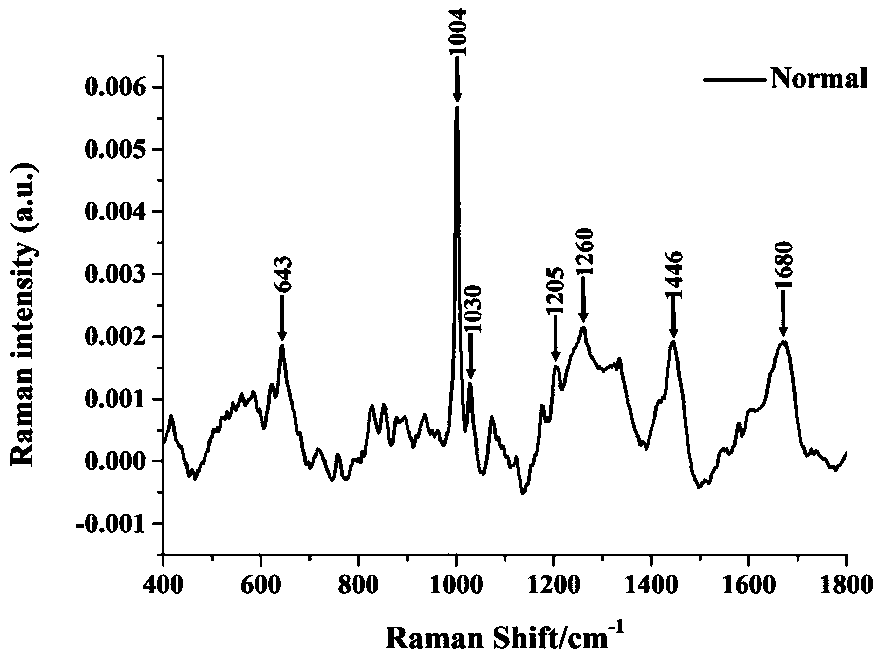SERS detection method based on adsorption of protein by hydroxyapatite nanoparticles
A hydroxyapatite and nanoparticle technology, applied in the field of protein analysis and detection, can solve the problems of large sample volume, expensive consumables, complicated steps, etc., and achieve the effects of less total protein, low experimental cost and simple operation.
- Summary
- Abstract
- Description
- Claims
- Application Information
AI Technical Summary
Problems solved by technology
Method used
Image
Examples
Embodiment 1
[0038] Surface-enhanced Raman spectroscopy detection of HAP5-adsorbed liver cancer serum protein based on silver nanoparticles substrate
[0039] Weigh 10 mg of HAP5 powder and add it to a 1.5 mL polypropylene centrifuge tube, add 1 mL of distilled water to the centrifuge tube, and disperse it ultrasonically for 10 minutes. Mix evenly, and then place the mixed solution at 100 rpm and incubate for 24 hours at 37° C. in a table-top shaking incubator. After 24 hours, centrifuge the incubated solution at 8000rpm for 10min, discard the supernatant, add 100µL of acid diluted 10 times to the centrifuge tube that retains the precipitate, adjust the pH value to 1.5, shake it well, let it stand for 5min, and then at 6000rpm, After centrifuging for 30 s, extract 10 µL of supernatant, mix the extracted supernatant with 10 µL of silver nanoparticles, place them on a 99.99% pure aluminum sheet, and dry them at room temperature for SERS spectrum detection. The laser excitation wavelength us...
Embodiment 2
[0041] Surface-enhanced Raman Spectroscopy Detection of HAP5 Adsorbed Normal Human Serum Protein Based on Gold Nanoparticle Substrate
[0042] The method for HAP5 to adsorb normal human serum and release protein is the same as in Example 1. Take 5 µL of gold nanoparticles and 5 µL of the final supernatant, mix them, place them on an aluminum sheet with a purity of 99.99%, dry them at room temperature, and perform SERS Spectral detection. The excitation wavelength of the laser used for detection is 785nm, and the spectral range is 400-1800cm -1 , the power is 10mW, the integration time is 30s, and the integration times are 2 times, the SERS spectrum of normal human serum protein is detected as figure 2 shown.
Embodiment 3
[0044] Surface-enhanced Raman Spectroscopy Detection of HAP5 Adsorbed BSA Based on Silver Nanoparticles Substrate
[0045] Weigh 0.1g of BSA and dissolve it in a certain amount of distilled water. After it dissolves naturally, dilute it in a 50mL volumetric flask to obtain a 1mg / mL BSA protein solution. Weigh 20mg of HAP5 powder and add it to a 1.5mL polypropylene centrifuge tube, add 2mL distilled water to the centrifuge tube, ultrasonically disperse for 10min, measure 1mg / mL BSA solution 1mL, add it to the centrifuge tube after ultrasonic dispersion and shake fully until Mix evenly, and then place the mixed solution at 100 rpm and incubate for 24 hours at 37° C. in a table-top shaking incubator. The method for HAP5 to adsorb BSA and release protein is the same as that in Examples 1 and 2. Take 20 µL of silver nanoparticles and 20 µL of the final extracted supernatant, mix them, put them on a 99.99% pure aluminum sheet, dry them at room temperature, and perform SERS spectrum...
PUM
| Property | Measurement | Unit |
|---|---|---|
| Wavelength | aaaaa | aaaaa |
Abstract
Description
Claims
Application Information
 Login to View More
Login to View More - R&D
- Intellectual Property
- Life Sciences
- Materials
- Tech Scout
- Unparalleled Data Quality
- Higher Quality Content
- 60% Fewer Hallucinations
Browse by: Latest US Patents, China's latest patents, Technical Efficacy Thesaurus, Application Domain, Technology Topic, Popular Technical Reports.
© 2025 PatSnap. All rights reserved.Legal|Privacy policy|Modern Slavery Act Transparency Statement|Sitemap|About US| Contact US: help@patsnap.com



